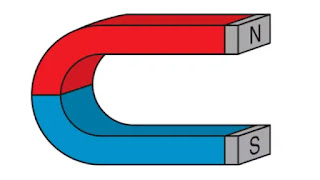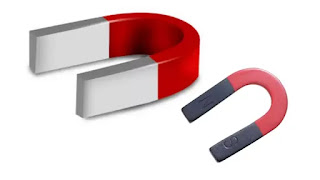Who Discovered Magnet
Magnes Shepherd and Magnet Discovery - There are many stories about who discovered magnets. According to an old Greek story, magnetism was discovered by a shepherd named Magnes, living in Magnesia, Greece.
About 4000 years ago, this shepherd was feeding its sheep in the mountains. At the same time, black sticks were attached to the stick of Magnes and iron in his sandals.
Apart from this, he found that the stone has such a quality that
the iron parts in its sandals are sticking to that stone. Since this incident, that magnetized stone became known as Magnetite after the name of Magnes Shepherd. But some historians believe that the "Magnet" is named after Megnesia, Greece where this stone was first found.
Magnetite, a natural magnetic element (Fe3O4), is found in Lodestone (magnetized stone) found by Magnes.
The magnet is also mentioned in ancient Indian and Chinese texts of the 6th century BCE. According to another story about the discovery of magnets, the Greeks discovered magnetite magnets in Turkey. According to another claim, Chinese people have been using magnetic compass for centuries.
Thales - which circa 600 BC Lived in Greece - was one of the earliest scholars to study magnets. Also mention of magnetism in the first century BC. Also found in the writings of Lucretius and Pliny the Elder (Rome 23–79 AD, Pliny the Elder).
Pliny referred to a hill near the Indus River which was entirely built of a stone that had the ability to attract iron. But he believed the magnet's attraction power to be a magical power.
People of that era used magnetite to drive away evil spirits due to superstition and ignorance, and to attract ships made of iron, etc.
1600 - William Gilbert and the first artificial magnet - The first artificial magnet was invented in 1600 by the British scientist William Gilbert (1544–1603). Not only this, he also proved that the Earth is a big magnet in itself.
William Gilbert also found that iron can be changed to magnetize it. In his book titled "De Magnet" (1600), William Gilbert mentions how to make magnets artificially from steel.
1820 Hans Christian Oersted and the discovery of electromagnetism - Hans Christian Oersted discovered the relationship between electricity and magnetism and discovered electromagnetism.
He demonstrated through a demonstration in 1820 that if the compass of a magnet is placed near an electric wire, the needle of the compass of that magnet is not able to show the right direction, influenced by the magnetic force of the electromagnet. Thus revealed the relationship between Electricity and Magnetism.
The use of magnets - The discovery of magnets and its properties has brought many revolutionary changes in our lives.
Magnets are used today in important daily use items such as TVs, computers, marine transportation, Magnetic Resonance Imaging machines, credit and debit cards, speakers and microphones, cranes, electric motors and generators, etc.
Magnets are now also used to run maglev trains. Magnets are being used and studied a lot in education and research as well.
Knowledge of the properties of magnets -
Attraction - The magnet attracts iron objects such as iron, cobalt, and nickel. Repulsive or Repulsion - Uniform magnetic poles repel each other and opposite magnetic poles attract each other. Directive Property - If any magnet is hung freely in the air, it always points in the north-south direction.
What we all know about a magnet is that it is a magnet is a material or object that pulls a magnetic object or a metal such as iron, and attracts when the bar of the magnet hangs freely. Its ends always stay in the north-south direction because of this property, load stone has also been called.
The most popular magnet was discovered by an elderly Cretan shepherd named Magnet who was grazing his sheep in an area of northern Greece about 4,000 years ago, showing him a magnet-like piece of stone because whenever he went to graze the sheep
While wearing shoes that had a layer of iron on them, one day some stone pieces of his shoes got stuck, then he saw how these pieces are.
So and when he dug something, magnetite, a natural magnetic material found. For many years after its discovery, magnetite was engulfed in superstition and thus, the sick were healed, to frighten and attract away evil spirits and to make ships made of iron.
The ability to dissolve was considered as magical powers, then it was researched slowly and then people came to know how it works and what is the fact that they studied the properties of William Gilbert magnet in England Was the first to do. He studied the properties of magnets for nearly 17 years.
They are not attracted by magnets, they are called non-magnetic materials. Such as wood, paper, rubber, stone, glass, gold, silver, aluminum etc. Artificial magnets cannot be made from these materials. The substances which are attracted by the magnet are called magnetic materials.
Materials such as iron, nickel, cobalt, etc., can be made from these materials as artificial magnets. Unlike poles, poles always attract each other, while similar poles always repel each other. That is, north-south will attract each other, while north-north and south-south will repel each other.
The earliest discovery of the properties of magnets was done by either the Greeks or the Chinese. In the understanding of magnetism was used by William Gilbert in 1600, it was for the first time that Gilbert realized that the Earth was a giant magnet.
Some magnets are also found naturally. There are two types of magnets manufactured such as permanent magnets and temporary magnets and there is a difference between the two.
Permanent magnet
Magnets that do not lose their magnetic properties are called permanent magnets. They are made from hard magnetized material and it remains without any reduction in normal conditions and without any reduction under normal conditions.
Floating magnet
In contrast, a magnet that loses its magnetic properties is called a temporary magnet. Such as: Magnets made of iron, steel, cobalt, nickel.
These magnets generate magnetic field only when electric current is passed through their used wires. At the end of the current, their magnetic field becomes almost zero. That is why they are also called electromagnets or electromagnets.












